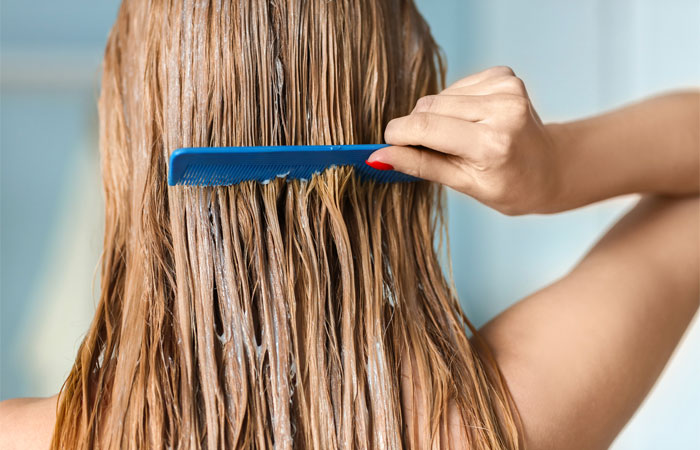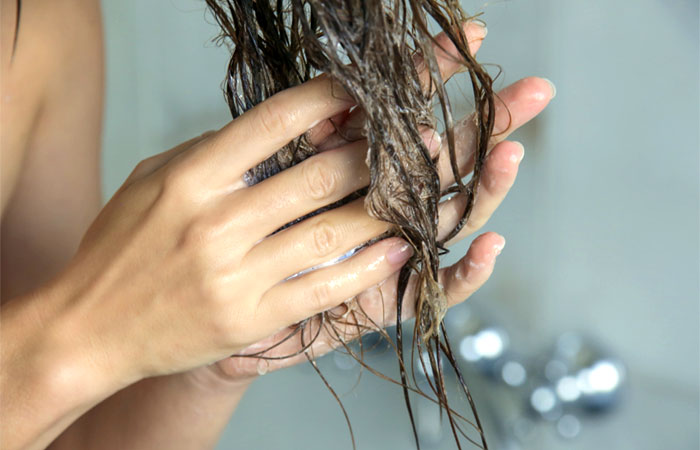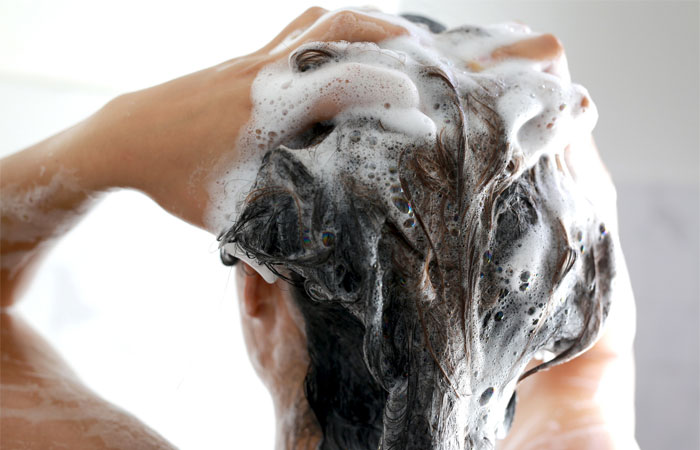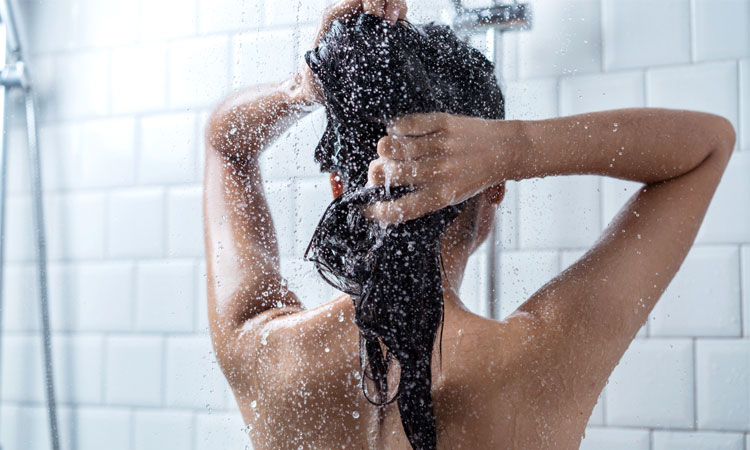With all the abuse we put our hair through, from bleaching to heat styling, it is likely in need of some pampering. One way to keep your delicate strands in tip-top shape is by using hair masks.
With regular use, even color chameleons and frequent hot tool users can have stronger, healthier hair.
Table of Contents
What Is a Hair Mask?
Hair masks are specially formulated to make hair healthier. They have special ingredients that can strengthen hair, give it an infusion of moisture, impart vital nutrients, invigorate the scalp, and even brighten dull hair color. They are meant to be used after you shampoo in place of your regular conditioner.
See Also: Use Shampoo or Conditioner First?
Hair Mask Benefits
Life is hard on your hair. From blow-drying and coloring to driving with the windows down, it goes through a lot.
On average, hair grows about one-half inch a month. That means the hair around your shoulders is around 2 years old. That’s 2 years of brushing, drying, coloring, curling, and other rough treatment.
By using hair masks regularly, you feed your hair the nutrients it needs to stay strong and healthy.
Hair Mask vs Deep Conditioner
At first glance, hair masks and deep conditioners may seem interchangeable. Many companies will have both words on the packaging calling the product a deep conditioning mask.
Since most masks are meant to be used after shampooing your hair, they are all moisturizing to some extent. But, moisture is not the only thing your hair may need. A deep conditioner is just like the name suggests. It is basically the same as a conditioner but usually has heavier moisturizers that hydrate the hair more deeply than your regular post-shampoo conditioner.
Hair masks, on the other hand, are formulated with specific ingredients to help take care of your hair beyond just moisture. Some are made to brighten hair color, like a purple hair mask for blondes. Some have proteins in them to help rebuild weak and damaged hair.
And, some are even made to help maintain the balance of natural scalp oils for those with oily hair.
How To Apply A Hair Mask
Step 1: Wash Your Hair
Wash hair as normal and then gently blot the hair or let it air dry until it is no longer dripping and saturated with water, but still damp. If the hair is still dripping, it can dilute the product and some of it will drip out of the hair before it has had time to do its magic.
Step 2: Section and Apply
Divide hair into manageable sections, more for thick hair and fewer for fine hair, so you can apply the mask evenly throughout your entire head. Unless it’s a scalp treatment, apply only to the length of the hair, not the roots.
The strength of the ingredients can overwhelm the hair at the roots making it look limp and greasy. The amount you use should start with the recommended amount written on the product packaging, but keep in mind that longer and thicker hair will require more.
Step 3: Let It Sink In
The amount of time you leave a mask on can be anywhere from 3 minutes to overnight. The average hair mask stays on for about 5 to 20 minutes. It is important to stick to the directions on the package, especially the first time you use a mask.
If the mask you use is on the shorter side and only needs to be left in for a few minutes, you can put on a shower cap to keep the water from rinsing it out while you continue your shower. This is a good time for exfoliating or shaving your legs, but you might want to save the body wash for after you rinse the conditioner out.
As you rinse, the heavy moisturizers in the mask will run down your back and can clog pores resulting in “bacne”. If your mask requires a longer time, it is a good time to shut off the shower, get in a robe, and practice some self-care. If you leave the shower, put your hair up loosely in a clip and put on a shower cap.
For deeper product penetration, put a towel in the dryer until it’s warm and wrap it around the shower cap. The heat will help the ingredients sink into the hair, making the mask even more effective. Whichever way you choose, set a timer and enjoy pampering yourself.
Step 4: Rinse and Enjoy Your Silky Strands
When it’s time to remove the mask, take the shower cap off and rinse thoroughly.
The water temperature should be lukewarm or cooler. The colder water will further close the cuticles of the hair shaft, locking the ingredients in and leaving hair looking shiny and healthy.
What Happens If You Leave a Hair Mask On Too Long?
This depends on the product and your hair type. Some formulas are made for being used overnight and can be left in longer without worry.
But, some formulas, particularly those for damaged hair that use words like “reconstructing”, “strengthening”, and “repair” on the label often have protein in them which aren’t good to use for longer periods of time. The balance of protein is delicate, and too much of a good thing can be bad.
It won’t be an issue if left in for a little too long one day when time got away from you, but doing so repeatedly isn’t beneficial.
Other than those made with proteins, all most hair masks will do if left in too long is make your hair heavy with moisturizers leaving it hard to style. This is especially true for fine and oily hair, which will feel weighed down by heavy moisturizing ingredients.
That said, more time doesn’t matter when it comes to benefits. If done regularly it is not necessary to leave a hair mask in beyond the amount of time written on the instructions.
If you don’t often use them and just bleached your hair or had a long week of harsh heat styling then leaving a moisturizing mask in for a few extra minutes might be helpful, but only to a certain point. The hair can only absorb so much at once, so it is rarely necessary to go beyond the suggested time.
It is more beneficial to use it as suggested and add it to your regular routine. This will make sure your hair stays in shape, looking shiny and healthy.
How Often Should You Use a Hair Mask?
How often you use a hair mask depends on hair type and what you put your hair through. A color-changing chameleon will need it more often than untouched hair will.
Length, dryness, and thickness of the hair all play a role, but the rule of thumb is that a hair mask should be used about once a week.
See Also: How Often Should You Use a Conditioner?
Additional Tips
There are so many amazing hair masks on the market today. When you go down the aisle trying to decide on a hair mask, make sure you choose one that is right for your hair’s needs.
If you have thick hair, a light moisturizing mask might not be the best choice. If you have oily hair, a heavy mask may be too much. If your hair has more than one need, like dry and color-treated hair, you can buy one for each need and alternate using them.
Hair masks can be used whenever you need them, but those with very fine or oily hair may want to use the hair mask on a day off if it is the first time using it. That way if it leaves your hair limp or looking greasy you don’t have an important meeting or event to go to.
No matter what your hair type, masks are a great addition to any hair care routine. They can strengthen hair, keep it manageable, and help keep expensive hair color looking fresh and bright.




